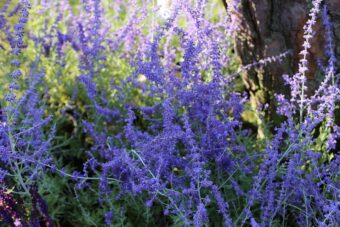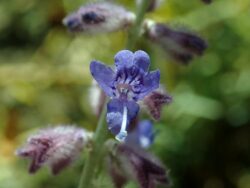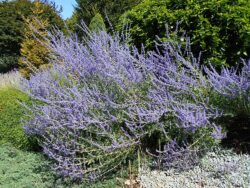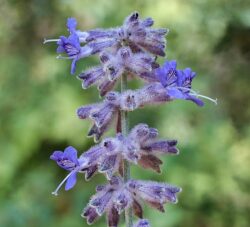In this article, we will discover how to grow the beautiful and prolific flowering shrub of Perovskia in containers. It used to belong to its own genus of Perovskia, but as with a lot of plants with DNA analysis. It has moved to the Salvia genus, where 8 species are known to exist.
The common species used to be called Perovskia atriplicifolia which has been renamed Salvia youngii.

The shrubs are naturally found growing in Southwest and central Asia. It is a member of the Salvia (the Sage) family but is given a subgenus within this family. It is officially known as Salvia subspecies Perovskia. The only species you are likely to find is Salvia youngii (Syn. Perovskia atriplicifolia). It has the common name of Russian sage and is a flowering subshrub.
To the uneducated and from a distance it can be mistaken for an overgrown lavender bush. It has an upright stiff growing habit and typically grows up to 1.2m in height. The stems are squarely shaped and have long, narrow grey-green leaves that contrast very well with the blooms that are produced. The leaves when crushed produce a distinctive smell.
It is grown for the long periods that the tall stems are in flower. From Mid-summer all the way to late October the silvery-grey leaves are topped with blue to violet blooms arranged in branched panicles. The flowers are followed by fruits about a month after flowering that consist of dark brown oval capsules that contain the seeds of the plant. The flowers are very attractive to insects so are a must for those that want to container garden for the wildlife.
Find out how to grow Perovskia (Salvia subspecies Perovskia) in containers.
GROWING PEROVSKIA IN CONTAINERS

As Perovskia can be tall, you need to grow in a large container that is well-balanced and proportional to the plant in question. Whatever container you decide to use make sure it has plenty of drainage holes at the bottom. To this container, add a 2cm layer of gravel to aid drainage further. On top of this gravel create a free-draining growing media by mixing 70% by volume of multipurpose compost with 30% by volume if washed building sand. Fill the container up to 5cm below the rim with this growing media.
Dig a hole at the centre of the container slightly bigger than the root ball it came in the original container. Drop the plant in so that the top of the root ball is at the same level as the top surface of the compost. Backfill with the growing media, using more compost if you find it necessary. Firm the plant in and water well.
THE BEST GROWING CONDITIONS
They do best grown in full sun and away from the rain. This is why a free-draining growing media is very important. Like all hardy plants, it prefers to be on the dry side rather than wet.
When it is well-established it will take drought pretty well and until this happens water when it feels dry to the touch. Otherwise, water when 5cm below the top surface of the compost feels dry to the touch. When you water do so until it emerges from the drainage holes.

As the plant can grow in poor soil to moderate fertile it does not need to be fed. In early spring if you deem it to be necessary, you can feed with a slow-release, general-purpose fertilizer as the manufacturer’s recommended dosage. Do not overdo it but feed if you find that your Russian sage is struggling and looks weak and feeble.
Pruning is a simple matter as all you need to do is cut back all stems to 5cm above the ground in April.
To propagate you can plant semi-ripe cuttings in a cold frame in summer for planting outside in the following year.
PESTS AND DISEASES
The good news is that if you are looking for a plant that does not suffer from any pests and diseases then this is for you. They are hardy and easy to look after, what more can you ask from a plant?
VARIETIES TO GROW

The one species you are likely to find is Perovskia atriplicilfolia and it is still sold as such, although it is now classified as Salvia youngii. It is a subshrub that grows up to 1m tall with sprays of lavender-blue flowers that are 30cm long. It provides an end-of-season colour where not much colour exists.
The big drawback is that after cutting in spring, little in the way of new growth is seen until mid-spring making the plant a late start to the new growing year.
Varieties to grow include the lavender ‘Blue Spire’ and the dark blue ‘Lacey Blue’. Another alternative with a vivid blue flower is ‘Crazy Blue’, ‘Little Spire’ and the ‘Silvery Blue’.
CONCLUSIONS
In this article, we have discovered how to grow the wonderful, elegant and late flowering shrub of Perovskia in containers. It may have changed its genus and moved to Salvia, but this does not take away from its beauty, its ease of growth or care.
A plant that is well worth the effort and you will soon be singing its praises.
If you have any questions or comments that you wish to make on growing Perovskia in containers, please do so in the comment box below.
Happy Perovskia growing.
